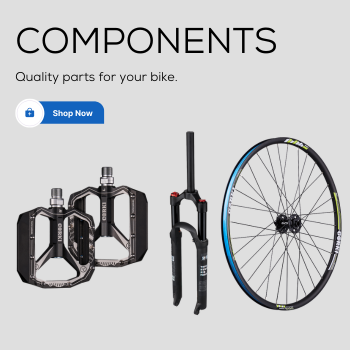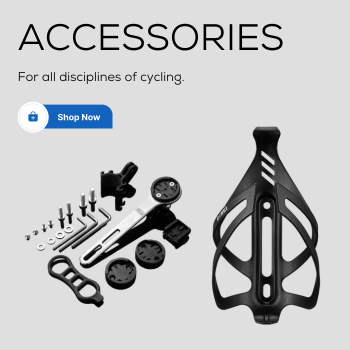
Understanding Suspension Components: Upgrading Your Mountain Bike's Performance
Bike suspension is an important factor that contributes to riding enjoyment. It provides better control, traction, and comfort on rooty, rocky singletrack or potholed roads.
Suspension technology has made huge progress in recent years and continues to improve. This has resulted in an abundance of information available on the topic. While it takes an expert to understand the intricacies of suspension, we are here to explain the basic need-to-know for all mountain bikers.
This article is aimed at new bike shoppers or anyone considering an upgrade and covers the basics of suspension. We will also discuss things you need to know about how to upgrade your bike suspension.
Full Suspension? Hardtail?
Most mountain bikes today have suspension, which makes the ride smoother and more controlled on rough terrain.
Bikes with shocks on the front only are known as hardtails, while bikes with suspension shocks on the front and rear are called dual suspension bikes. A rigid bike has no suspension.
If you are in the market for a new bike with suspension, you will have the option between one or two shocks, depending on your needs and budget. Dual-suspension bikes are better for rougher trails than hardtail bikes, but they are more expensive and heavier due to extra moving parts. The added weight and cost are worth it because dual-suspension bikes have better handling on rough terrain.

Front Suspension
Front suspension or front shocks on a bicycle are referred to as forks. There are many different options and brands available, and changing them is a fairly easy process, provided that you ensure the travel length and wheel size are compatible. The fork comprises two struts that connect the front wheel to the head tube of the frame. These struts, also known as "stanchions" in the cycling world, move up and down within their housing to provide shock absorption.
Click here to learn more about the front suspension fork.
- Everything You Need to Know About Front Suspension Forks
Rear Suspension
Rear suspension, known as the "shock," is designed to be built into the bike frame. Shocks are customized to match different frames, so they are typically not interchangeable. In some cases, a shock is made exclusively for a specific frame and cannot be used with any other bike.
The rear suspension is exclusive to dual-suspension mountain bikes, also known as "full-sus" or "allies" in mountain bike language.
The rear shock sits under the rider between the front and rear triangles and is contained within a pivot system that uses linkages to allow the shock to move within the frame. On heavy-duty downhill and enduro mountain bikes, coil-sprung shocks are still widely used as they handle heat better. However, they offer fewer fine-tuning adjustment options and add weight.
It consists of a shock body casing that encloses two telescopic tubes. The tubes compress under a load, referred to as stroke travel. The shock absorber is connected to the frame via a pivot system of linkages built into the frame.
Rear shocks come in different shaft diameters, can either be air or coil-sprung, and offer various tuning and adjustability options to suit the rider's needs. Most suspension brands provide similar options for adjusting your suspension, but the method for making these adjustments can vary. The easiest way to figure out which dial or button to adjust is by checking the manufacturer's website and reading the instruction manual. These manuals are designed to be user-friendly, with clear instructions and graphics to make the process simple. Trust us, it's worth taking the time to read through the manual carefully.
Suspension Tuning
One of the first things you need to do when setting up your suspension fork is to use sag. Sag is the amount of suspension that settles with the rider's weight and gear in a neutral stance. It is a simple metric that determines the stiffness of the air spring proportional to the load. This load consists of your weight, the weight of the bike, and the gear attached to it.
While most manufacturers provide a pressure chart based on rider weight, suspension tuning is not an exact science. I think sag is the best tool for suspension setup because it's a ratio that can be applied to bikes with a load.
For more information on how to adjust your suspension, you can check out this link:
- How to Adjust Your Front Suspension Forks Quickly?
Upgrading Suspension Components
Benefits of Upgrading
- Better springs and dampers
- Extra features
- Lower weight
- More stylish
When it comes to riding on rough terrain, good springs, and dampers are crucial for a comfortable and stable ride. High-end air springs are especially effective in increasing comfort and traction. Quality dampers offer better control and adjustability, making it easier to navigate tough terrain. The best enduro and downhill dampers provide independent high and low-speed compression and rebound adjustment for suspension enthusiasts to customize their ride.
Considerations Before Upgrading

Know your riding style
When thinking about upgrading your bike's rear suspension, it's important to consider your riding style. Do you prefer steep descents or cross-country trails? This will affect the suspension upgrade that is best for you.
If you love tackling technical descents and aggressive terrain, you'll want a suspension setup that offers maximum plushness and control. Look for shocks with ample travel and robust damping characteristics to absorb big hits and maintain stability at high speeds. But if you're more into cross-country racing or all-day endurance rides, you'll want a suspension setup that prioritizes lightweight efficiency and responsiveness. Consider air shocks with adjustable settings to fine-tune your ride feel and optimize pedal efficiency without sacrificing comfort on rough trails.
Budget wisely
Consider how much you can realistically spend on upgrading your suspension. While top-of-the-line components offer superior performance, they may not be necessary for casual riders.
These high-end suspension components all come with supple-feeling air or coil springs and high-performance dampers that provide extra adjustability. You should expect to pay $800-1,200 for a good fork and $300-600 for a good shock. (Of course, it's possible to spend more.) However, that doesn't mean you must break the bank for a quality upgrade. Many mid-range suspension options offer excellent performance at a more affordable price point.
Prioritize features
When choosing suspension components, focus on features that are most important to you, such as adjustability, compatibility with your bike frame, or ease of tuning. Make sure the suspension components you choose are compatible with your bike frame and intended use. Check for compatibility in mounting hardware, eye-to-eye length, and stroke length to ensure everything fits well. Choose upgrades that meet your specific needs in order to get the most value for your investment.
Popular Upgrade Options
If you're in the market for a fork or shock upgrade, there are several popular brands and models worth considering.
- Fox Factory Series
- Fox Performance-Elite
- RockShox Ultimate
- Ohlins
- Cane Creek
- Push
While there are many other suspension manufacturers available, these options are widely available, and most suspension shops are likely to be familiar with their servicing process.
Conclusion
To fully enjoy mountain biking, you need to upgrade your bike's rear suspension. This means getting the right shock absorber and adjusting compression and rebound settings. These key factors will help optimize your bike's performance on the trail. It's important to explore the different options for suspension upgrades so you can improve your ride and take on new adventures.
Happy trails!




